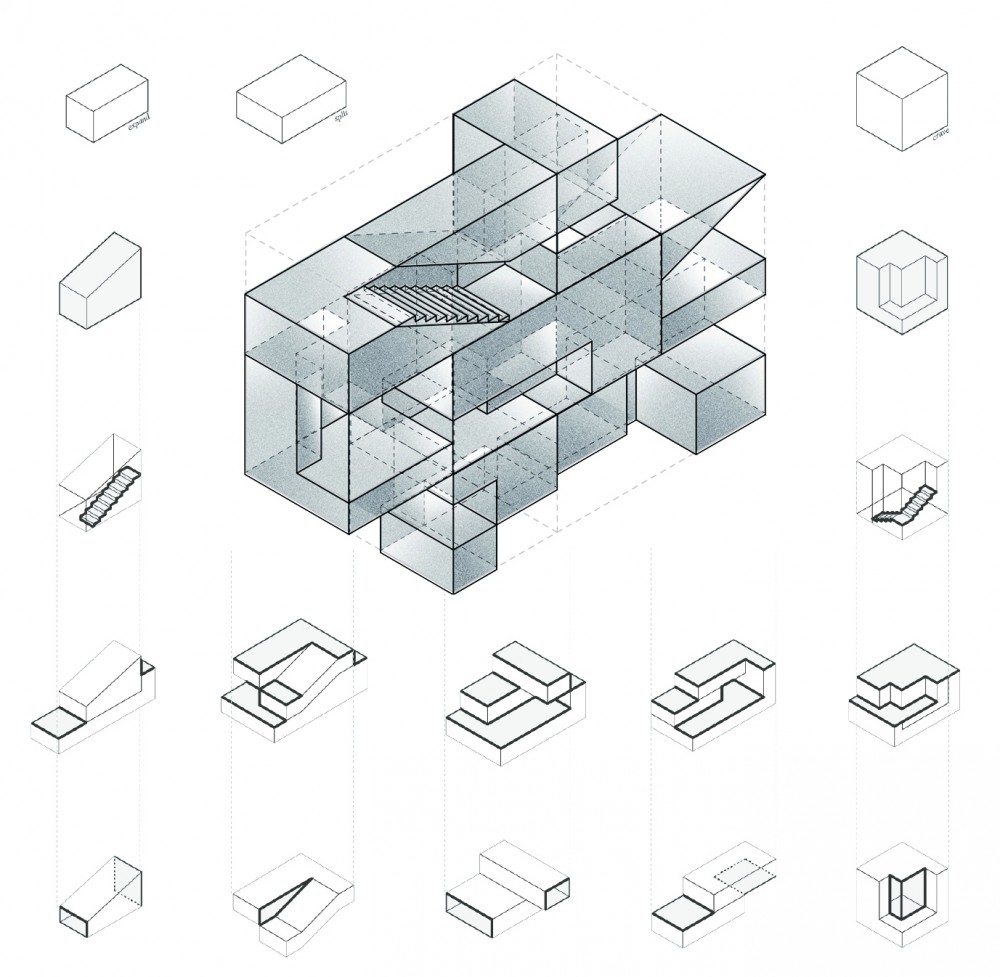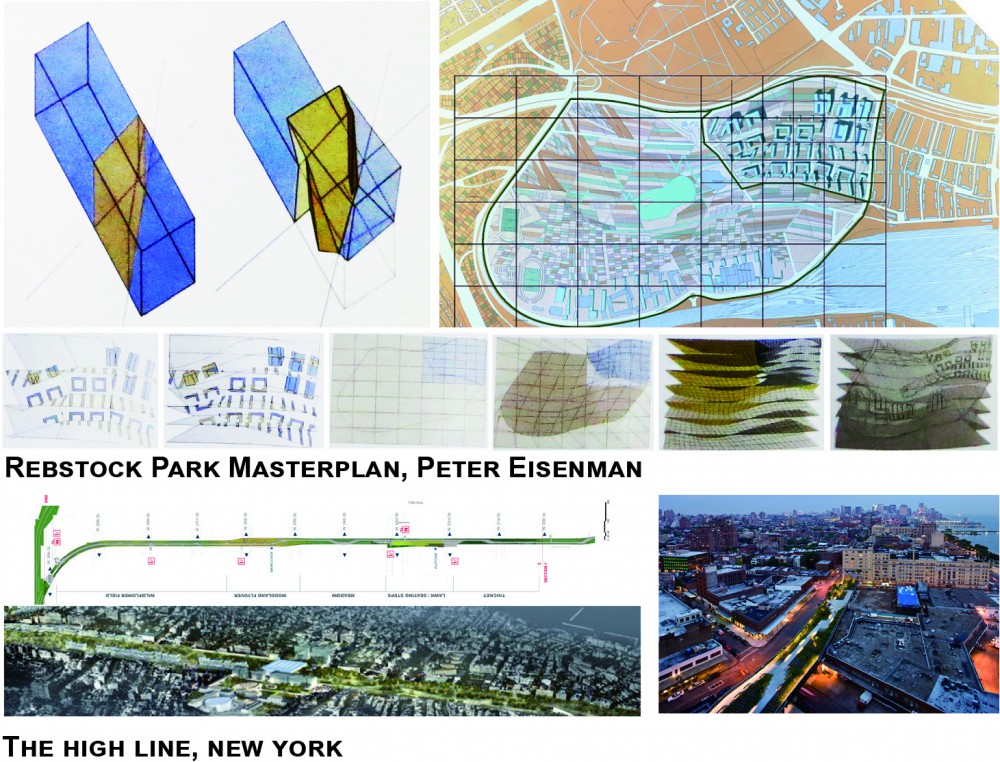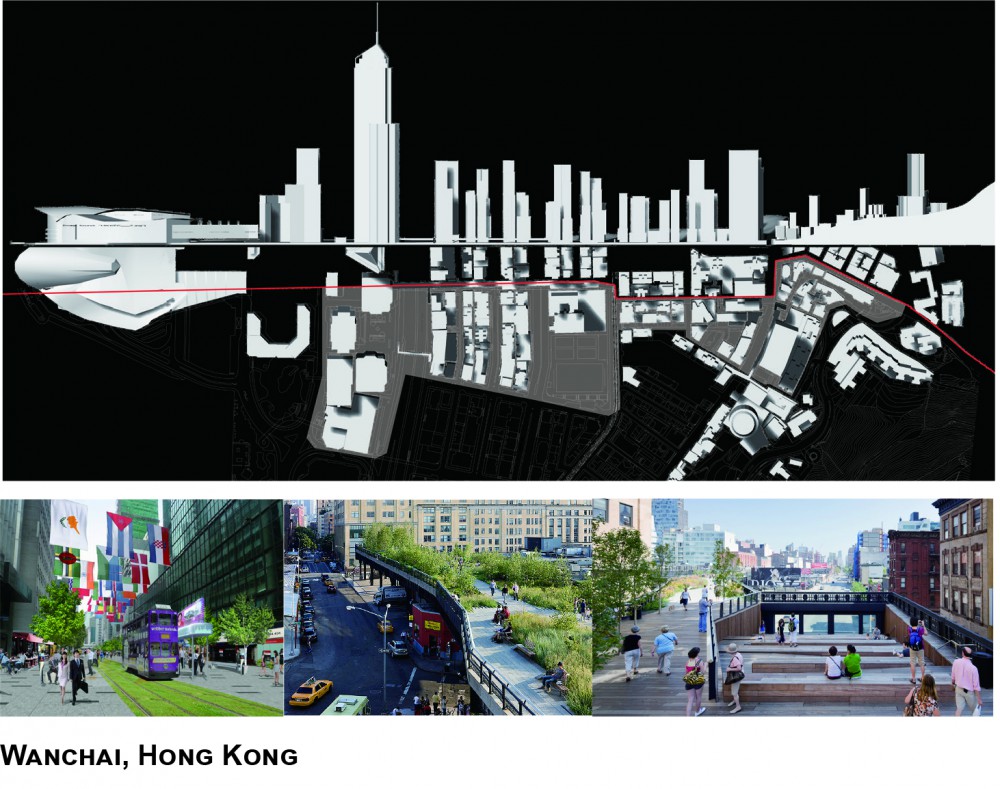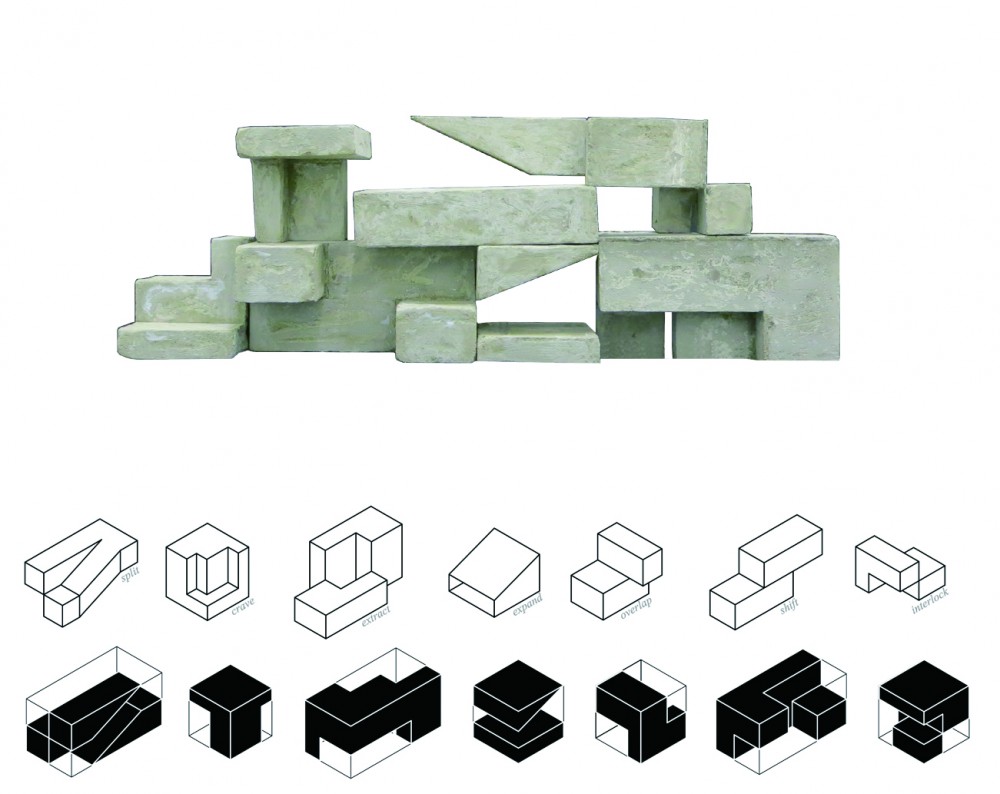|
|
ARTIFACT

This thesis suggests how a basic volume be operated with verbs as a
fundamental design tool of generating the volumetric hybrids.
This inspires a logic and systematic approach on consideration of spatial
character or programatic needs by operating of actions.
This thesis aims at provoking abstract spatial thinking and volumetric interplay
to develop a new method of exploring spatial experience and architectural
interpretation.
WHY?

Historical
Rebstock Park Masterplan edeavours to reassess the entire idea of a static urbanism, one which deals only with objects rather then events. Framed by a segment of the Mercator Grid, this masterplan floats within a rectilinear container to obscure the residual position. By compressing the large grid segment onto the site perimeter and similarly compressing the small scale grid onto the close site, cotingent readings emerge as the two site figures fold and nfold, each relative to its expanded position. Rather than being seen as an abrupt tline, the idea of the fold gives the traditional idea of edge a dimension.
Precedent
The High Line is a precedent urban park that reclaims a former elevated railroad for new use, promoting timely principles of ecological sustainability, urban regeneration and adaptive reuse. Preservation and innovation come together to establish an urban corridor for habitat, wildlife and people. In addition to providing valuable open space for New York City, the High Line has become an economic generator for the neighborhood, attracting investment toward new cultural institutions, commercial and residential development.
My Position
Operative verbs are used as an approach in design process to consider the interaction of volumes in space, relationship of interior and exterior, at various scales and perspectives. The actions are defined to differentiate how they operate volumetrically responding to programmatic requirements and given site coditions. My position is to develop a method of forming to mediate and reframe the condidtions such as old and new, transport and arrival, commerce and hosuing. This method could be used on the site to initiate new social organisayions of urban space and to reframe existing organistions.
WHAT?

The site, scale and scope
The site will be situated along a selected section which lies along Hennessy Road, Johnston Road, Tai Wo Street, Wan Chai Road and Stone Nullah Lane. The total distance of such section is approximately 500 m and it covers two tram stations in between the Southern Playground. I will look into the relationship of the tramway with streetscape, the connectivity of the traffic ad social flow from the tram stops. Also, the topography, urban fabric of the city and the people activity would be my scope of research.
Theorization of the site selection
To further develop my design methodology, I would like to explore how the spatial action can yield in a larger sense of scale and complexity. The designed volumes/conditions (with actions) are used to test out the volumetric relationships and spatial connectivity by joining and assembling. And, a forming system is to intergrate related to its volume and spatial charcter to promote the human movement and social interaction bwteen spaces.
Why is this site
The tramway extends from the west to the east of Hong Kong Island and running through different distrcts with distinguished streetscape character. Meanwhile, the contemporary city connection is confing the urban life from a collage one to a journey between two points only. The transportation system poorly articulating the relationship bwteen public ad private, means people are less likely to stay, slowing doen the paces or engage with a place. By addressing the physical nature of Wan Chai streetscape, leftover/ pocket spaces, I try to reestablish the neccessary conditions for social activity and programatic need in a built environmnet in Wan Chai.
HOW?

Physical Modelling is used to test the inter-relationship of volumes and connectivity of spaces. By joining and assembling the
designed volumes, I try to develop a forming system and logic.
Stage 01 – Analytical Design Research:
Case study analysis with similar objective, scale, scope or material. Eg. Reserach on the high line, public space, micro-urban
space, high density streetscape or dynamic landscape design. Due on Dec 29.
Site analysis on history, background of the tramway, urban fabric, street context, circulation, opportunities and deficiencies on site.
Due on Jan 5.
Stage 02 – Design Synthesis
Generation of Design drawing and model with concept. Eg, Continuity, accessibility, street ambience, program, activities.
Experiement with physical modeling, well categorized and defined conditions of spatial verbs and action. Exploration for spatial
creation and quality. Due on Jan 26.
Review 1.0 Rehearse/ refine/present/write. Due on Feb 2.
Stage 03 – Testing the method
Testing and Refining the method by Physical Modeling on volumes with combined actions and aggregations, related to the site
conditions and needs. Review 2.0 Rehearse/ refine/present/write. Due on Mar 16.
Stage 04 – Revision/Refinement
Justification with digital modeling and renderings, associated programs should be considerably designed as followed. Review 3.0
Rehearse/ refine/present/write. Due on Apr 27.
BIBLIOGRAPHY
1. Kenneth Frampton, 1920-1945, Modern Architecture, New York: Rizzoli International Publications 2. Steven Holl, 2000, ”Correlational
Programming” in Parallax, Princeton_New York, 212-213 3. Léonor Mégrot-Desallais Faculté d’Architecture La Cambre-Horta ULB – Bruxelles – Master inspired
by Aldo Van Eyck 4. Anthony Di Mari & Nora Yoo, 2012, Operative Design, BIS Publishers 5. K. Michael Hays, 1973-1984, Opposition reader: selected readings
from a journal for ideas and criticism in architecture, New York : Princeton Architectural Press 6. Greg Lynn, 2004, Folding in architecture, Chichester, West
Sussex : Wiley-Academy 7. K. Michael Hays, 1998, Architecture theory since 1968, Cambridge, Mass : The MIT Press 8. Kaijima, Momoyo, 2006, Made in
Tokyo, Tokyo ; Kajima Institute Pub. Co.
|



